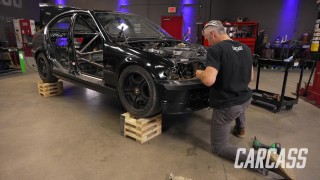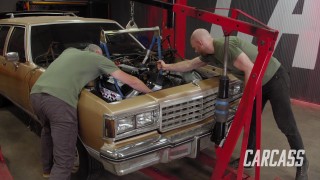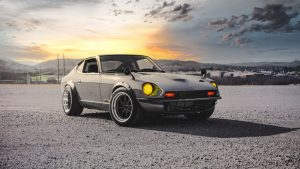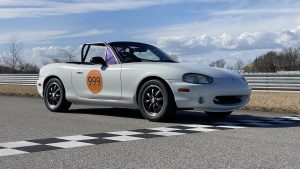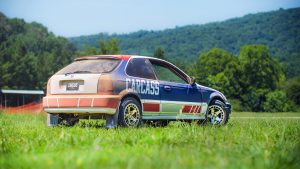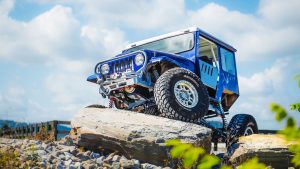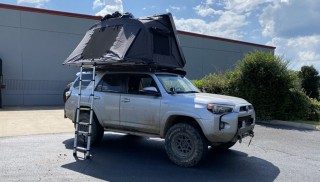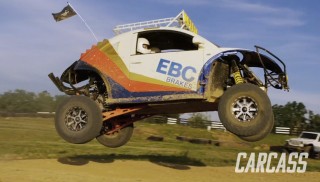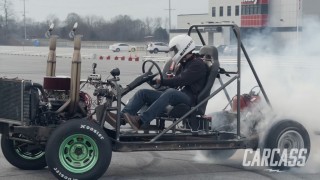Carcass Featured Projects
Carcass Builds
Want more content like this?
Join the PowerNation Email NewsletterParts Used In This Episode
Matco Tools
MATCO Tools are the Official Tool Supplier to PowerNation
Mickey Thompson
Mickey Thompson Baja Pro X tires
The Industrial Depot
Tools, Hardware, Shop Supplies
Tom Wood's Custom Drive Shafts
Drive shaft for Willy's
Episode Transcript
(Jeremy)>> Today on
Carcass we bury our Willys wagon in the mud.
(Jimmy)>> That's right! With a few cuts here and a few welds there this bad boy is ready to get dirty.
(Narrator)>> When you want to build something different you turn to these guys, Jeremy Weckman and Jimmy King. Jeremy was raised in Minnesota building street rods. He's a builder, fabricator, and welder. Jimmy grew up in Nevada working in his dad's garage building cars. He's a mechanical engineer, builder, and fabricator. They take left for dead rides and transform them into one of a kind builds. If you can dream it they can build it. This is Carcass, a non-traditional speed shop.
(Jeremy)>> This our Willys mud wagon. Let's take a look back at how Jimmy and I transformed this 67 year old vehicle into what you see today.
(Jimmy)>> We started our journey with a mostly stock 1953 Willys wagon. We threw out the chassis and were left with a body that was in fairly good shape minus the firewall.
(Jeremy)>> Then we rolled in a Chevy M-1010 military ambulance that came from the National Guard. We lifted the box out back and the cab up front. Then we started on the chassis stripping it of the gas tank, the exhaust, and even the powertrain.
(Jimmy)>> The M-1010 chassis was way too long. So we cut and removed over two feet from the middle and welded it back together. Then we custom fab some body mounts for the Willys body.
(Jeremy)>> Before we could marry the two together we had to do some modifications to the body. We cut up an old junk firewall, added a basic roll cage, and put the gas tank and the radiator in the back.
(Jimmy)>> We were done with the body but this chassis still had some upgrades coming its way before we could see this duo in action. So we gave this tough frame four more inches of height and dropped in a 630 horsepower drivetrain.
(Jeremy)>> At this point we were finally ready to drop the Willys body on the frame. Seeing how this tall mud monster was gonna sit.
(Jimmy)>> With comparing height aside we needed to replace the firewall we cut out with one of our own creation, and the rear drum brakes got a makeover with a disc brake conversion.
(Jeremy)>> All that was stopping us from firing this thing up were some hoses and some fuel line. We threw on a Holley Sniper e-f-i setup and some zoomie headers, priming our mud wagon for the inaugural startup. [ engine starting and revving ]
(Jimmy)>> And as you can tell by my reaction this thing is fearsome. With 630 horses rumbling through a pair of zoomies it got my blood pumping. [ Music ] We're about on the home stretch. We just have the rest of the body panels put on, get the pedals in, steering, and some other interior stuff.
(Jeremy)>> Yeah we've got the steering to work with, the brakes to work with. That includes the hydra-boost. We've also got the driveshafts to put in and those monster 43 inch tires.
(Jimmy)>> That's really gonna finish off the look, and also cutting a hole in the hood is gonna finish off the look to get the top end of that guy sticking out of it.
(Jeremy)>> It's time to put Humpty Dumpty back together again, and our Willys mud wagon has an iconic grille that must be put back on this thing. So to start we'll put on the front fenders.
(Jimmy)>> The fenders are a simple install but require two people. One to hold it in position while the other adds the hard to get to bolts.
(Jeremy)>> With the two fenders installed we can add that recognizable front grille that will bolt to the fenders and the custom body mount we made up front.
(Jimmy)>> The last item to be installed will be the hood, but we already know it won't fit just because of how tall our engine is. So we're gonna have to make some modifications. We'll measure the width to the outside of the headers and how much room the scoop takes up front to back.
(Jeremy)>> Back at the hood we'll start laying out those measurements. We'll use the body lines as a natural line to follow for the width of our cut. Since we used our actual measurements to make our marks we're gonna use a couple different sized rolls of masking tape to add some uniform clearance to our cuts. We'll use two inch tape on the sides and one and half inch tape for the front and rear cuts on the hood.
(Jimmy)>> Now we're not gonna get to cutting right away. We're gonna start with the corners first. Our engine is solid mounted, and it's gonna shake and rattle around, and corners are very prone to cracking. So we're gonna round the corners off to prevent that and it's gonna give us some style points.
(Jeremy)>> To accomplish this we'll use an inch and three quarter hole saw. We'll line the edge of that up with the outside edge of our tape without the pilot bit installed. This will allow us to mark the center. Then we'll come back with the drill, apply even pressure to punch our way through the hood.
(Jimmy)>> We'll follow that up with a cutoff wheel carefully following the outside of our tape lines. As we cut we'll work our way around meeting each of the rounded corners until we reach the last corner setting the sheet metal free.
(Jeremy)>> There ain't no turning back now. Time for a test fit. We need to remove the scoop up top and the air filters because we know the hood isn't going to completely fit in this state. The air cleaner and the scoop overlap the hood just a little bit. So we'll mark that and then take it back to the bench to cut it out. We'll use the same hole saw to take care of the corners and trim the rest like earlier. [ saw buzzing ]
(Jimmy)>> Now we're ready to see how this bad boy looks. With a few finishing touches our nearly 70 year old hood gets a tough new look. [ Music ]
(Jeremy)>> Up next we give the front end of our Willys mud wagon a hot rod look with a beer keg.
(Jimmy)>> It's good to see the hood's back on this thing.
(Jeremy)>> Yeah we've got plenty of clearance around the exhaust. We've got clearance around the scoop. The hood opens and closes but if we get into some deep mud and some water there's a chance we can pull that mud and water up through the scoop into the engine and that could hurt it. So we're gonna have to come up with a different way to get air into it and I think I have a solution with pulling air out of the cab but I'm not too concerned about that right now. What I am concerned about is why do you have a keg?
(Jimmy)>> Well there's that part of the chassis that sticks beyond the front of the grill and just this weird empty space. So I figured we could fill it with this keg.
(Jeremy)>> You know a lot of street rodders, they used to use that for gas tanks and stuff. That's made out of aluminum and there's some aluminum stuff up front. So it just kinda goes together.
(Jimmy)>> Yeah and it's not too much work to finish off the look.
(Jeremy)>> We're going all nostalgic on the Willys wagon but don't worry this is just for looks. We're keeping the fuel and the cooling system out back. This is just gonna up the cool factor.
(Jimmy)>> To kick start this cool addition we'll have to take a measurement up front between the two frame rails.
(Jeremy)>> We'll transfer the measurements to our inch and a half square tubing and make the cut. [ saw buzzing ]
(Jimmy)>> We'll clean up the ends and prep them for welding using a conditioning disc. Then by clamping our tubing in we can tack it in. [ welder crackling ]
(Jimmy)>> Don't forget to tap that keg guys.
(Jeremy)>> Well set the keg in place resting it on the tubing. Then we'll mark where the strap securing the keg will be attached.
(Jimmy)>> To find the length of our straps we'll use some string and wrap it around the keg. Then we'll measure the string and add a few inches for some flanges.
(Jeremy)>> With those measurements determined we'll cut some sections of inch and a half strapping and then give it some curve in the slip roller.
(Jimmy)>> Now it's time to make the flanges on the ends. By inserting one end in the vice we'll utilize some leverage with a large wrench making a slight bend. Then we'll center punch the end, and using our Matco step drill bit we'll hog out a hole in the strap. We'll follow that up with the belt sander to round off the corners.
(Jeremy)>> With our straps in hand we're almost ready to make our keg a permanent fixture to our Willys mud wagon, but before we can do that we need to measure for some standoffs so our keg won't rattle on the cross bar.
(Jimmy)>> We'll cut those at 10 degrees on the saw, and prep the welder to put it all together. The standoffs go first. Each of those will get tacked into place. Then we'll grab the curved straps and lay them out evenly over the standoffs. These will get a few tacks to hold them in place as well. One last check.
(Jeremy)>> We'll test fit the keg to make sure everything lines up.
(Jimmy)>> Looking thirsty.
(Jeremy)>> With everything looking good we can burn in our cross supports, standoffs, and our set of straps. Now we noticed there was a little bit of flex in the strapping. So we added supports to reinforce the base. [ welder crackling ]
(Jimmy)>> All there's left to do is set the keg in place, add the straps, pull them tight, and cut the excess. This wound up being a really cool addition to our mud truck.
(Jeremy)>> Yeah you know it definitely brings that old school nostalgic feel to the mud wagon. We could stand here all day and admire everything we've done to this build but we want to get this thing driving. So the shifter is what we're gonna touch on next. The shifter assembly we got from Summit Racing is fairly easy to install. The only tough part is working in tight quarters. The main plate goes on first, screwing into the casting mounts on the transmission.
(Jimmy)>> Next we need to position the shifter body on top of the plate and mark the area where we need to cut the trans tunnel. We'll do this from the top side.
(Jeremy)>> Now you may be asking yourself how in the heck are we gonna mark the top side of the tunnel? Well that's easy. We'll just count the ribs on the bottom side of the tunnel. Then we'll do the same on the top side to locate our starting point.
(Jimmy)>> Using a spare piece of metal, we'll protect our wiring from any sparks and we'll begin our cut using a cutoff wheel. We'll carefully cut along our line creating a rectangle long enough to allow the shifter to fully travel.
(Jeremy)>> We can now pass the shifter through the hole. Then with the help of a buddy we can position it over the main bracket and install the hard to get to screws. A quick tip. If your fingers can't get into those hard to reach areas but a wrench can just add a little bit of masking tape to the ends. That way it has just enough material to grab onto the nut to get into those hard to reach places.
(Jimmy)>> With the shifter not secured to the main plate we need to install the trans gear lever. It's a quick bolt on. Following that we need to measure the length of the threaded rod that will connect the shifter to the trans gear lever. You'll want to make sure both of these are in the park position.
(Jeremy)>> We'll transfer that measurement to our threaded rod subtracting an inch and three quarter for the rod ends. Then we'll just trim it off with a cutoff wheel. With our rod ends installed we can now marry our transmission to our shifter. One end goes to the trans gear lever and the other connects to the quad lever on the shifter. Then we'll just snug up the set nuts on the rod ends. A quick test in the cab makes sure that everything functions properly. We have a ton to do before this beast can slosh around in the mud. Coming up we knock out brakes, steering, and add some massive mud tires.
[ Music ]
(Jeremy)>> Alright dude I am so pumped. Let's put these wheels and tires on cause I want to see how they look.
(Jimmy)>> We can't yet.
(Jeremy)>> Why not?
(Jimmy)>> We can't stop, we can't steer. There's other things we've got to do before we can even drive it.
(Jeremy)>> Alright let's get working on the list then.
(Jimmy)>> Let's see, we've got a steering column to swap, brake pedal, master cylinder, brake lines, throttle pedal. We need to clean up electrical and we need to throw on some mud tires. Let's get started.
(Jeremy)>> We have a couple of components that are perfectly good to use from our M-1010 body. The steering column is in perfect working condition and so is the brake pedal assembly. Neither of these we'll have to spend any coin on.
(Jimmy)>> At the Willys body we'll check the placement of the brake pedal. Then we'll take the assembly over to the table to make a template. This will help us locate the stud and bolt holes on our custom firewall.
(Jeremy)>> Before we can throw in the brake pedal assembly we need to make some minor tweaks to the dash, cutting away the lower portion.
(Jimmy)>> With that cleared out of the way we can bolt in our brake pedal and check it's placement in relation to the seat. That is way too close. Since this pedal isn't made for this vehicle we're gonna have to make a modification to the bracket. We'll start by cutting off the end of the bracket that we want to save. Then we'll outline the portion that we need to remove, cut it. Finally we'll weld it back together and install it back in the cab.
(Jeremy)>> With the hard part out of the way we can move on to our steering setup. We need to cut a quick hole in the firewall and run the column through it. We'll attach the boot to the firewall, add a bar for support, and then attach the column to the bar with a couple of bolts.
(Jimmy)>> To finish off our steering we need to make the connection to the steering box. We'll do that with a U-joint we got from Summit Racing.
(Jeremy)>> Now with our steering setup we have a short list left to do. We'll first install the master cylinder and hydro-boost on the firewall. Then on the engine we'll install a bracket that we fabbed up, followed by the power steering pump and mount we got from Summit Racing dot com. We'll hook up the hoses from our pump to our hydro-boost. Then connect our new brake lines to our master cylinder, and the other end, well that goes to our brake hose from our caliper.
(Jimmy)>> We need to clean up the wiring in the cab and we'll reuse the gauges that were in the vehicle when we bought it. We'll throw in a race car style gas pedal we got from Summit Racing, and make the throttle cable connection up the throttle bodies, followed by front and rear driveshafts we got from Tom Woods Custom Driveshafts.
(Jeremy)>> And the icing on the cake, 17 inch mag wheels we got from Summit Racing paired with a set of 43 inch Baja Pro-X tires we got from Mickey Thompson. Alright man well this thing's finally ready to go hit the mud holes but before we take this out I think we should give it a wash.
(Jimmy)>> A wash?
(Jeremy)>> Yeah so I got this Hybrid Solution from Turtle Wax and it's gonna help us protect the finish of our Willys. This ceramic wash and wax solution has three things that are gonna help us clean, shine, and protect our paint. The first is the hydro glide wash polymers. Now that's gonna give us a scratch free wash. Second are the synthetic wash polymers, which increase the depth of color and add shine. And finally we have the super hydrophobic and silicon dioxide polymers, which increase water beading.
(Jimmy)>> And that makes sense because we're gonna throw this truck through a bunch of mud and water.
(Jeremy)>> Exactly and I can't wait. So let's go grab a bucket. We'll wash this beast during the break but stick around cause we're gonna get this thing filthy.
[ Music ] [ engine revving ] [ ratchet clicking ] [ engine starting ] [ Music ]
(Jeremy)>> This is the first time we're getting behind the wheel of our Willys mud wagon, and I can't be any more excited cause this is exactly what we did back home in Minnesota.
(Jimmy)>> And what a better place to take our mud monster than American Rebel Mud Park in Waynesboro, Tennessee. Approximately 500 acres and situated on the banks of the Buffalo River, this park is designed as an escape for mudders and enthusiasts. Riders can test their skills in the mud pits, take to the shallows, or have an adventure on the scenic trails. With a park like this it's needless to say that this is the perfect place to take our Willys mud wagon on its first test drive.
(Jeremy)>> Now we made some modifications up front to make sure our engine didn't pull in any debris. We turned the scoop backwards and we added three intake tubes to pull clean air from inside the cab.
(Jimmy)>> And we added a torque arm to prevent axle wrap under hard acceleration. [ engine revving ] [ Music ]
(Jeremy)>> Alright man what do you say we take it easy here for the first little bit?
(Jimmy)>> Yeah I think we go up a little bit at a time and then see if we can't put this thing through the ringer.
(Jeremy)>> Yeah there's a little pit right here. So let's start right here.
(Jimmy)>> Sounds good. [ engine revving ]
(Jeremy)>> Alright man that truck's a little too clean. It's time to get it dirty. You go for it. [ Music ]
(Jimmy)>> The first and second puddles were about the same. A lot of water, a lot of mudslinging off the tires, but the third puddle wasn't so easy. I was looking at it from over the hood and it didn't look that deep, and then my front tire sank and I thought this might be a problem.
(Jeremy)>> Oh that's deep, oh that's deep! Stop, out of the throttle.
(Jimmy)>> So I gunned it hoping to get the wheel speed up to get out of the mud but the tires just kept getting deeper and deeper in the mud, and well I got stuck.
(Jeremy)>> That's just good ole fashioned fun right there. [ Music ] Dude I thought we were gonna take it easy?
(Jimmy)>> Minor miscalculation. Yeah I went into this one and I'm like. [ bleep ]
(Jimmy)>> Right when I got in I started sinking, I'm like out #*%^.
(Jeremy)>> The Willys is finally feeling at home in the mud but maybe this hole was a little too deep.
(Jimmy)>> Alright so first run of the day off to not so hot of a start. We got the truck stuck. Kinda reiterates my I don't love lifted trucks but this is one problem you get stuck in the mud you have to pull it out. So Jeremy's getting the F-350 I am sitting on my personal island. [ Music ] [ engine revving ] [ Music ]
(Jeremy)>> So if I could rewind to the beginning of the day and draw this picture of exactly how I wanted the Willys to look that right there is 100 percent how I thought it would look. That's awesome! [ engine revving ]
(Jimmy)>> I'm filthy, the truck's filthy. We got it out of the mud. So now it's Jeremy's turn to thrash this thing.
(Jeremy)>> On my run I'm gonna take a slightly different approach. I'm gonna play around in the shallows, figure out how the truck acts, and figure out how the mud is gonna act, and then once I'm confident that the truck can do this we're gonna hit the deep end and then the ultimate goal is not to get stuck. [ engine revving ]
(Jeremy)>> The shallows went great and I have all the faith in the world that we can push our Willys mud wagon into some deeper water. So we're gonna whip this thing around this pit and hope we don't get stuck on the other side. [ engine revving ]
(Jimmy)>> This mud hole wasn't as deep as the one I ran into to, but when Jeremy ventured into the deep end the blower belt starting shoot water out of the cutout in the hood. [ engine revving ]
(Jimmy)>> Nice driving slick.
(Jeremy)>> Dude that is an absolute animal but it kinda felt like something was rubbing towards the end there. I don't know what's going on. The center section legit broke off the tubes.
(Jimmy)>> That's gnarly dude! That's not supposed to look like that. You think it's gonna make it back to the trailer?
(Jeremy)>> Yeah I think it will but you know what? I think we've got to call it a day, but man look at this thing. It did everything we wanted it to do.
(Jimmy)>> This is supposed to look like at the end of the day anyway.
(Jeremy)>> Yeah it wasn't supposed to be clean. For more information on anything you've seen today check us out on Powernation TV dot com.
Show Full Transcript
(Jimmy)>> That's right! With a few cuts here and a few welds there this bad boy is ready to get dirty.
(Narrator)>> When you want to build something different you turn to these guys, Jeremy Weckman and Jimmy King. Jeremy was raised in Minnesota building street rods. He's a builder, fabricator, and welder. Jimmy grew up in Nevada working in his dad's garage building cars. He's a mechanical engineer, builder, and fabricator. They take left for dead rides and transform them into one of a kind builds. If you can dream it they can build it. This is Carcass, a non-traditional speed shop.
(Jeremy)>> This our Willys mud wagon. Let's take a look back at how Jimmy and I transformed this 67 year old vehicle into what you see today.
(Jimmy)>> We started our journey with a mostly stock 1953 Willys wagon. We threw out the chassis and were left with a body that was in fairly good shape minus the firewall.
(Jeremy)>> Then we rolled in a Chevy M-1010 military ambulance that came from the National Guard. We lifted the box out back and the cab up front. Then we started on the chassis stripping it of the gas tank, the exhaust, and even the powertrain.
(Jimmy)>> The M-1010 chassis was way too long. So we cut and removed over two feet from the middle and welded it back together. Then we custom fab some body mounts for the Willys body.
(Jeremy)>> Before we could marry the two together we had to do some modifications to the body. We cut up an old junk firewall, added a basic roll cage, and put the gas tank and the radiator in the back.
(Jimmy)>> We were done with the body but this chassis still had some upgrades coming its way before we could see this duo in action. So we gave this tough frame four more inches of height and dropped in a 630 horsepower drivetrain.
(Jeremy)>> At this point we were finally ready to drop the Willys body on the frame. Seeing how this tall mud monster was gonna sit.
(Jimmy)>> With comparing height aside we needed to replace the firewall we cut out with one of our own creation, and the rear drum brakes got a makeover with a disc brake conversion.
(Jeremy)>> All that was stopping us from firing this thing up were some hoses and some fuel line. We threw on a Holley Sniper e-f-i setup and some zoomie headers, priming our mud wagon for the inaugural startup. [ engine starting and revving ]
(Jimmy)>> And as you can tell by my reaction this thing is fearsome. With 630 horses rumbling through a pair of zoomies it got my blood pumping. [ Music ] We're about on the home stretch. We just have the rest of the body panels put on, get the pedals in, steering, and some other interior stuff.
(Jeremy)>> Yeah we've got the steering to work with, the brakes to work with. That includes the hydra-boost. We've also got the driveshafts to put in and those monster 43 inch tires.
(Jimmy)>> That's really gonna finish off the look, and also cutting a hole in the hood is gonna finish off the look to get the top end of that guy sticking out of it.
(Jeremy)>> It's time to put Humpty Dumpty back together again, and our Willys mud wagon has an iconic grille that must be put back on this thing. So to start we'll put on the front fenders.
(Jimmy)>> The fenders are a simple install but require two people. One to hold it in position while the other adds the hard to get to bolts.
(Jeremy)>> With the two fenders installed we can add that recognizable front grille that will bolt to the fenders and the custom body mount we made up front.
(Jimmy)>> The last item to be installed will be the hood, but we already know it won't fit just because of how tall our engine is. So we're gonna have to make some modifications. We'll measure the width to the outside of the headers and how much room the scoop takes up front to back.
(Jeremy)>> Back at the hood we'll start laying out those measurements. We'll use the body lines as a natural line to follow for the width of our cut. Since we used our actual measurements to make our marks we're gonna use a couple different sized rolls of masking tape to add some uniform clearance to our cuts. We'll use two inch tape on the sides and one and half inch tape for the front and rear cuts on the hood.
(Jimmy)>> Now we're not gonna get to cutting right away. We're gonna start with the corners first. Our engine is solid mounted, and it's gonna shake and rattle around, and corners are very prone to cracking. So we're gonna round the corners off to prevent that and it's gonna give us some style points.
(Jeremy)>> To accomplish this we'll use an inch and three quarter hole saw. We'll line the edge of that up with the outside edge of our tape without the pilot bit installed. This will allow us to mark the center. Then we'll come back with the drill, apply even pressure to punch our way through the hood.
(Jimmy)>> We'll follow that up with a cutoff wheel carefully following the outside of our tape lines. As we cut we'll work our way around meeting each of the rounded corners until we reach the last corner setting the sheet metal free.
(Jeremy)>> There ain't no turning back now. Time for a test fit. We need to remove the scoop up top and the air filters because we know the hood isn't going to completely fit in this state. The air cleaner and the scoop overlap the hood just a little bit. So we'll mark that and then take it back to the bench to cut it out. We'll use the same hole saw to take care of the corners and trim the rest like earlier. [ saw buzzing ]
(Jimmy)>> Now we're ready to see how this bad boy looks. With a few finishing touches our nearly 70 year old hood gets a tough new look. [ Music ]
(Jeremy)>> Up next we give the front end of our Willys mud wagon a hot rod look with a beer keg.
(Jimmy)>> It's good to see the hood's back on this thing.
(Jeremy)>> Yeah we've got plenty of clearance around the exhaust. We've got clearance around the scoop. The hood opens and closes but if we get into some deep mud and some water there's a chance we can pull that mud and water up through the scoop into the engine and that could hurt it. So we're gonna have to come up with a different way to get air into it and I think I have a solution with pulling air out of the cab but I'm not too concerned about that right now. What I am concerned about is why do you have a keg?
(Jimmy)>> Well there's that part of the chassis that sticks beyond the front of the grill and just this weird empty space. So I figured we could fill it with this keg.
(Jeremy)>> You know a lot of street rodders, they used to use that for gas tanks and stuff. That's made out of aluminum and there's some aluminum stuff up front. So it just kinda goes together.
(Jimmy)>> Yeah and it's not too much work to finish off the look.
(Jeremy)>> We're going all nostalgic on the Willys wagon but don't worry this is just for looks. We're keeping the fuel and the cooling system out back. This is just gonna up the cool factor.
(Jimmy)>> To kick start this cool addition we'll have to take a measurement up front between the two frame rails.
(Jeremy)>> We'll transfer the measurements to our inch and a half square tubing and make the cut. [ saw buzzing ]
(Jimmy)>> We'll clean up the ends and prep them for welding using a conditioning disc. Then by clamping our tubing in we can tack it in. [ welder crackling ]
(Jimmy)>> Don't forget to tap that keg guys.
(Jeremy)>> Well set the keg in place resting it on the tubing. Then we'll mark where the strap securing the keg will be attached.
(Jimmy)>> To find the length of our straps we'll use some string and wrap it around the keg. Then we'll measure the string and add a few inches for some flanges.
(Jeremy)>> With those measurements determined we'll cut some sections of inch and a half strapping and then give it some curve in the slip roller.
(Jimmy)>> Now it's time to make the flanges on the ends. By inserting one end in the vice we'll utilize some leverage with a large wrench making a slight bend. Then we'll center punch the end, and using our Matco step drill bit we'll hog out a hole in the strap. We'll follow that up with the belt sander to round off the corners.
(Jeremy)>> With our straps in hand we're almost ready to make our keg a permanent fixture to our Willys mud wagon, but before we can do that we need to measure for some standoffs so our keg won't rattle on the cross bar.
(Jimmy)>> We'll cut those at 10 degrees on the saw, and prep the welder to put it all together. The standoffs go first. Each of those will get tacked into place. Then we'll grab the curved straps and lay them out evenly over the standoffs. These will get a few tacks to hold them in place as well. One last check.
(Jeremy)>> We'll test fit the keg to make sure everything lines up.
(Jimmy)>> Looking thirsty.
(Jeremy)>> With everything looking good we can burn in our cross supports, standoffs, and our set of straps. Now we noticed there was a little bit of flex in the strapping. So we added supports to reinforce the base. [ welder crackling ]
(Jimmy)>> All there's left to do is set the keg in place, add the straps, pull them tight, and cut the excess. This wound up being a really cool addition to our mud truck.
(Jeremy)>> Yeah you know it definitely brings that old school nostalgic feel to the mud wagon. We could stand here all day and admire everything we've done to this build but we want to get this thing driving. So the shifter is what we're gonna touch on next. The shifter assembly we got from Summit Racing is fairly easy to install. The only tough part is working in tight quarters. The main plate goes on first, screwing into the casting mounts on the transmission.
(Jimmy)>> Next we need to position the shifter body on top of the plate and mark the area where we need to cut the trans tunnel. We'll do this from the top side.
(Jeremy)>> Now you may be asking yourself how in the heck are we gonna mark the top side of the tunnel? Well that's easy. We'll just count the ribs on the bottom side of the tunnel. Then we'll do the same on the top side to locate our starting point.
(Jimmy)>> Using a spare piece of metal, we'll protect our wiring from any sparks and we'll begin our cut using a cutoff wheel. We'll carefully cut along our line creating a rectangle long enough to allow the shifter to fully travel.
(Jeremy)>> We can now pass the shifter through the hole. Then with the help of a buddy we can position it over the main bracket and install the hard to get to screws. A quick tip. If your fingers can't get into those hard to reach areas but a wrench can just add a little bit of masking tape to the ends. That way it has just enough material to grab onto the nut to get into those hard to reach places.
(Jimmy)>> With the shifter not secured to the main plate we need to install the trans gear lever. It's a quick bolt on. Following that we need to measure the length of the threaded rod that will connect the shifter to the trans gear lever. You'll want to make sure both of these are in the park position.
(Jeremy)>> We'll transfer that measurement to our threaded rod subtracting an inch and three quarter for the rod ends. Then we'll just trim it off with a cutoff wheel. With our rod ends installed we can now marry our transmission to our shifter. One end goes to the trans gear lever and the other connects to the quad lever on the shifter. Then we'll just snug up the set nuts on the rod ends. A quick test in the cab makes sure that everything functions properly. We have a ton to do before this beast can slosh around in the mud. Coming up we knock out brakes, steering, and add some massive mud tires.
[ Music ]
(Jeremy)>> Alright dude I am so pumped. Let's put these wheels and tires on cause I want to see how they look.
(Jimmy)>> We can't yet.
(Jeremy)>> Why not?
(Jimmy)>> We can't stop, we can't steer. There's other things we've got to do before we can even drive it.
(Jeremy)>> Alright let's get working on the list then.
(Jimmy)>> Let's see, we've got a steering column to swap, brake pedal, master cylinder, brake lines, throttle pedal. We need to clean up electrical and we need to throw on some mud tires. Let's get started.
(Jeremy)>> We have a couple of components that are perfectly good to use from our M-1010 body. The steering column is in perfect working condition and so is the brake pedal assembly. Neither of these we'll have to spend any coin on.
(Jimmy)>> At the Willys body we'll check the placement of the brake pedal. Then we'll take the assembly over to the table to make a template. This will help us locate the stud and bolt holes on our custom firewall.
(Jeremy)>> Before we can throw in the brake pedal assembly we need to make some minor tweaks to the dash, cutting away the lower portion.
(Jimmy)>> With that cleared out of the way we can bolt in our brake pedal and check it's placement in relation to the seat. That is way too close. Since this pedal isn't made for this vehicle we're gonna have to make a modification to the bracket. We'll start by cutting off the end of the bracket that we want to save. Then we'll outline the portion that we need to remove, cut it. Finally we'll weld it back together and install it back in the cab.
(Jeremy)>> With the hard part out of the way we can move on to our steering setup. We need to cut a quick hole in the firewall and run the column through it. We'll attach the boot to the firewall, add a bar for support, and then attach the column to the bar with a couple of bolts.
(Jimmy)>> To finish off our steering we need to make the connection to the steering box. We'll do that with a U-joint we got from Summit Racing.
(Jeremy)>> Now with our steering setup we have a short list left to do. We'll first install the master cylinder and hydro-boost on the firewall. Then on the engine we'll install a bracket that we fabbed up, followed by the power steering pump and mount we got from Summit Racing dot com. We'll hook up the hoses from our pump to our hydro-boost. Then connect our new brake lines to our master cylinder, and the other end, well that goes to our brake hose from our caliper.
(Jimmy)>> We need to clean up the wiring in the cab and we'll reuse the gauges that were in the vehicle when we bought it. We'll throw in a race car style gas pedal we got from Summit Racing, and make the throttle cable connection up the throttle bodies, followed by front and rear driveshafts we got from Tom Woods Custom Driveshafts.
(Jeremy)>> And the icing on the cake, 17 inch mag wheels we got from Summit Racing paired with a set of 43 inch Baja Pro-X tires we got from Mickey Thompson. Alright man well this thing's finally ready to go hit the mud holes but before we take this out I think we should give it a wash.
(Jimmy)>> A wash?
(Jeremy)>> Yeah so I got this Hybrid Solution from Turtle Wax and it's gonna help us protect the finish of our Willys. This ceramic wash and wax solution has three things that are gonna help us clean, shine, and protect our paint. The first is the hydro glide wash polymers. Now that's gonna give us a scratch free wash. Second are the synthetic wash polymers, which increase the depth of color and add shine. And finally we have the super hydrophobic and silicon dioxide polymers, which increase water beading.
(Jimmy)>> And that makes sense because we're gonna throw this truck through a bunch of mud and water.
(Jeremy)>> Exactly and I can't wait. So let's go grab a bucket. We'll wash this beast during the break but stick around cause we're gonna get this thing filthy.
[ Music ] [ engine revving ] [ ratchet clicking ] [ engine starting ] [ Music ]
(Jeremy)>> This is the first time we're getting behind the wheel of our Willys mud wagon, and I can't be any more excited cause this is exactly what we did back home in Minnesota.
(Jimmy)>> And what a better place to take our mud monster than American Rebel Mud Park in Waynesboro, Tennessee. Approximately 500 acres and situated on the banks of the Buffalo River, this park is designed as an escape for mudders and enthusiasts. Riders can test their skills in the mud pits, take to the shallows, or have an adventure on the scenic trails. With a park like this it's needless to say that this is the perfect place to take our Willys mud wagon on its first test drive.
(Jeremy)>> Now we made some modifications up front to make sure our engine didn't pull in any debris. We turned the scoop backwards and we added three intake tubes to pull clean air from inside the cab.
(Jimmy)>> And we added a torque arm to prevent axle wrap under hard acceleration. [ engine revving ] [ Music ]
(Jeremy)>> Alright man what do you say we take it easy here for the first little bit?
(Jimmy)>> Yeah I think we go up a little bit at a time and then see if we can't put this thing through the ringer.
(Jeremy)>> Yeah there's a little pit right here. So let's start right here.
(Jimmy)>> Sounds good. [ engine revving ]
(Jeremy)>> Alright man that truck's a little too clean. It's time to get it dirty. You go for it. [ Music ]
(Jimmy)>> The first and second puddles were about the same. A lot of water, a lot of mudslinging off the tires, but the third puddle wasn't so easy. I was looking at it from over the hood and it didn't look that deep, and then my front tire sank and I thought this might be a problem.
(Jeremy)>> Oh that's deep, oh that's deep! Stop, out of the throttle.
(Jimmy)>> So I gunned it hoping to get the wheel speed up to get out of the mud but the tires just kept getting deeper and deeper in the mud, and well I got stuck.
(Jeremy)>> That's just good ole fashioned fun right there. [ Music ] Dude I thought we were gonna take it easy?
(Jimmy)>> Minor miscalculation. Yeah I went into this one and I'm like. [ bleep ]
(Jimmy)>> Right when I got in I started sinking, I'm like out #*%^.
(Jeremy)>> The Willys is finally feeling at home in the mud but maybe this hole was a little too deep.
(Jimmy)>> Alright so first run of the day off to not so hot of a start. We got the truck stuck. Kinda reiterates my I don't love lifted trucks but this is one problem you get stuck in the mud you have to pull it out. So Jeremy's getting the F-350 I am sitting on my personal island. [ Music ] [ engine revving ] [ Music ]
(Jeremy)>> So if I could rewind to the beginning of the day and draw this picture of exactly how I wanted the Willys to look that right there is 100 percent how I thought it would look. That's awesome! [ engine revving ]
(Jimmy)>> I'm filthy, the truck's filthy. We got it out of the mud. So now it's Jeremy's turn to thrash this thing.
(Jeremy)>> On my run I'm gonna take a slightly different approach. I'm gonna play around in the shallows, figure out how the truck acts, and figure out how the mud is gonna act, and then once I'm confident that the truck can do this we're gonna hit the deep end and then the ultimate goal is not to get stuck. [ engine revving ]
(Jeremy)>> The shallows went great and I have all the faith in the world that we can push our Willys mud wagon into some deeper water. So we're gonna whip this thing around this pit and hope we don't get stuck on the other side. [ engine revving ]
(Jimmy)>> This mud hole wasn't as deep as the one I ran into to, but when Jeremy ventured into the deep end the blower belt starting shoot water out of the cutout in the hood. [ engine revving ]
(Jimmy)>> Nice driving slick.
(Jeremy)>> Dude that is an absolute animal but it kinda felt like something was rubbing towards the end there. I don't know what's going on. The center section legit broke off the tubes.
(Jimmy)>> That's gnarly dude! That's not supposed to look like that. You think it's gonna make it back to the trailer?
(Jeremy)>> Yeah I think it will but you know what? I think we've got to call it a day, but man look at this thing. It did everything we wanted it to do.
(Jimmy)>> This is supposed to look like at the end of the day anyway.
(Jeremy)>> Yeah it wasn't supposed to be clean. For more information on anything you've seen today check us out on Powernation TV dot com.







